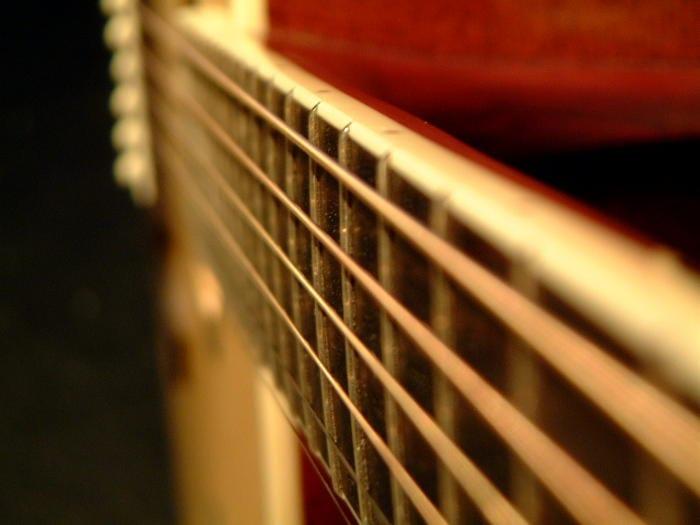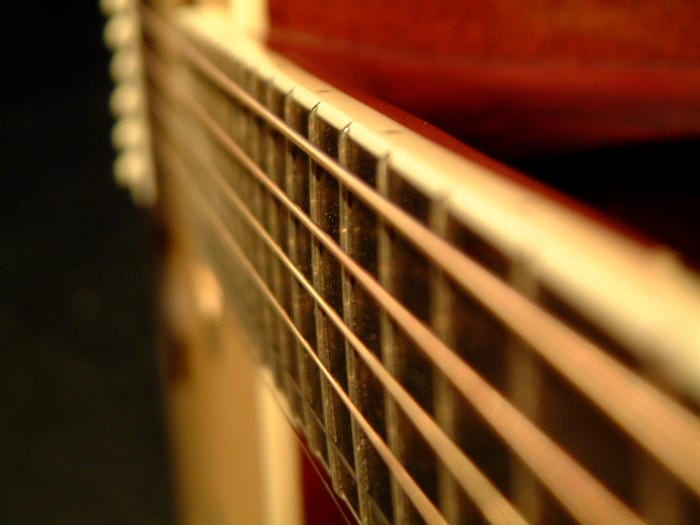When it comes to guitars, there are all sorts of different models, styles, and sizes. But one thing that all guitars have in common is strings. And while you might think that all strings are created equal, that’s actually not the case.
Differentials in materials and gauge can make a big difference in the sound of your guitar. In this blog post, we’ll take a look at the different types of strings on your guitar and when you should use them.
What Are the Main Strings on a Guitar?
A guitar typically has six strings, which are often made of steel or nylon:
- The three lower-pitched strings are typically referred to as the “bass” strings, while the three higher-pitched strings are known as the “treble” strings.
- The string in the middle is usually tuned to an E, while the string above it is tuned to a B. The top string is typically tuned to an E, but can also be tuned to a B or a high C.
- Guitars can also be equipped with more than six strings, which allows for a wider range of notes to be played.
- However, most guitarists prefer to stick with the traditional six-string setup.
Ready to master all the strings on guitar? Taking guitar lessons can help. Learn more about all of the benefits of guitar lessons by watching the video below:
https://www.youtube.com/watch?v=WfZ64yEGPok
How Often Should You Change Guitar Strings?
So how often should you change the strings on your guitar?
It depends on a few factors. If you play frequently, you will probably need to change your strings more often than someone who only plays occasionally.
Likewise, if you play in a band or perform live, the increased exposure to heat and perspiration will cause your strings to break down more quickly.
Another factor to consider is the type of strings you use. Coated strings, for example, can last up to three times longer than uncoated ones.
Ultimately, the best way to know when to change your strings is to listen to your guitar. If it starts sounding dull or lifeless, it’s probably time for new strings. By taking good care of your instrument, you can ensure that it will always be ready when you are.
How to Put Strings on Your Guitar
Putting strings on a guitar can seem like a daunting task, but it’s actually pretty straightforward once you know what to do. The first step is to loosen the tuning pegs on your guitar so that the holes are big enough to fit the string through.
Next, take the string and thread it through the hole in the tuning peg. Once the string is through the tuning peg, pull it tight and then wind the peg clockwise until the string is tight.
Repeat this process for each string until all of the strings are in place. Finally, tune your guitar and you’re ready to play!
How to Place Your Fingers on Guitar Strings
Start by sitting in a comfortable position with the guitar placed so that the strings are facing you. Then, place your left hand behind the guitar neck and position your thumb in the space between the neck and hand. Next, place your right hand in the middle of the body of the guitar and position your thumb at the back of the neck.
For your left hand, use your index finger to hold down the string at the first fret, use your middle finger to hold down the string at the second fret, and use your ring finger to hold down the string at the third fret. For your right hand, use your index finger to pluck or strum the strings. With a bit of practice, you’ll be playing chords like a pro in no time!
How to Tell What Gauge Strings Are On Your Guitar
If you’re a guitar player, then you know that the gauge of your strings can have a big impact on your sound. But what if you’re not sure what gauge strings are on your guitar? Here’s how to tell.
First, take a look at the size of the strings. If they are thinner, then they are most likely lighter gauge strings. If they are thicker, then they are most likely heavier gauge strings. Of course, this is only a general rule of thumb – there are always exceptions.
Next, take a look at the tuning pegs. If the pegs are spaced further apart, then that’s another indication that you have lighter gauge strings. The reason for this is that lighter gauge strings require less tension to stay in tune, so the pegs don’t need to be as close together.
Finally, give the strings a pluck and listen to the sound. Lighter gauge strings will generally have a brighter, twangier sound while heavier gauge strings will have a richer, fuller sound. Again, this is only a general rule – there are always exceptions – but it can give you a good idea of what gauge strings you have.
So now you know how to tell what gaugestrings are on your guitar. Just remember to experiment and find the gauges that work best for you and your playing style.
Changing the Strings on Your Guitar? Here are Some Tips
Each year the CMT honors country music stars at their Artists of the Year celebration – 2011’s honorees included Brad Paisley, Jason Aldean and Kenny Chesney. Before they were stars, however, they had to work up their guitar skills from the very beginning.
Of course, if you’d like to be the next musician in line for country stardom, you’ll need to keep your guitar at your side. Ideally, you should have already found the perfect guitar (or even better, maybe one of these.) Perhaps you’ve made a list of your all-time favorite songs that you want to learn, and you’ve written down your goals. But there’s one more thing you need to consider: what type of guitar strings are best for you? The quality of your strings can affect your guitar’s resonance and tone, impact your speed as a player, as well as make a different in your ability to finger pick – especially as a beginner.
We recommend speaking to your guitar teacher, who can give you recommendations specifically for your skill level and guitar type, and who will know the best place in town to purchase them. In the meantime, here’s a great article from Gibson about choosing guitar strings to check out:
Ideal Strings on Your Guitar for the Acoustic Player
As any guitar player knows, the type of strings you use can have a big impact on your sound. If you’re playing acoustic guitar, you’ll want to choose strings that emphasize the natural resonance of the instrument.
Fade to Bleak
Since there are no pickups or amps involved in acoustic guitar playing, string composition – which affects how a string responds to being struck and the retention of tonal qualities – is particularly important for acoustic guitars. Bronze, phosphor bronze and coated strings tends to be the preferred varieties, ascending in price. Bronze strings start out the brightest, but lose their high voices relatively quickly. Phosphor bronze offers a darker tone, but still with a clear, ringing top and the phosphor allows the strings to produce their optimum sound longer. On acoustic guitars, coated strings trade a longer life for less brightness, but good warmth and presence.
Lighten Up
Typically, heavier strings project more natural sound when struck, but for most live performers it’s practical to have an acoustic guitar with a pick-up for plug-and-play situations. Having a pickup in an acoustic guitar allows for the use of lighter gauge strings. Some acoustic guitars even respond well to slinky electric sets, like .10s, providing electric-guitar-like playability without sacrificing the chime of acoustic tones.
Them Changes
Since the strings on acoustic guitars play a much more important role in projecting volume and clarity than strings on an amplified electric guitar, consider changing acoustic guitar strings often to keep the instrument sounding its best. Remember to wipe down the strings after playing and check for string damaging fret wear. Both can prematurely end a guitar string’s life.
Ideal Strings on Your Guitar for the Electric Player
If you’re an electric guitar player, the type of strings you use can have a big impact on your sound. In general, electric guitars are better suited for thicker strings, which help to create a fuller, richer tone. However, there’s no hard and fast rule about what gauge of string is best for an electric guitar.
Fast Fingers
If speed’s the goal, most shred-heads prefer light gauge strings. They’re easy to bend and promote fast playing by offering less resistance to the fretting and picking hands. Since guitar strings are measured in thousandths of an inch, the typical recommended gauge for players planning to burn in standard tuning are .009s, available in every guitar shop.
Sound Judgment
Consider the sonic characteristics of the various materials used in making electric strings. Stainless steel strings are the least glamorous, but offer plenty of bright bite and sustain. Pure nickel has a warm old-school sound, for vintage tones. And nickel-plated steel is a bit brighter than classic nickel and responds more adroitly to picking attack. Chrome guitar strings are typically the province of jazz players or blues artists who are looking for the kind of warm retro tones chiseled into history by the likes of Charlie Christian or swinging bluesman Aaron “T-Bone” Walker. And then there are coated strings – the most expensive and theoretically the longest lasting. They are, however, not really the best, sonically speaking. Coated strings tend to have less sustain. Also, their Teflon exterior surfaces are slippery, which might take some getting used to for particularly aggressive electric guitar players. And when the coatings wear off, they rust like any other string.
Heavy is as Heavy Does
For low hanging alternate tunings like open D or dropped D, consider a heavy string gauge – at least .11s, although Stevie Ray Vaughan, who kept his instrument turned down just a half-step, employed a set gauged .13 to .58. Thicker strings will maintain their tension better when they’re low-tuned, which makes for less fret noise and other undesirable distortion. Many players feel thicker strings make for better slide playing, too, since the strings resist going slack under the pressure of the slide. But that’s really a matter of feel and learning to control a slide more than a string thing.
Ultimately what feels the best under your fingers and sounds right should determine your strings – so play around and figure out what your preference is.
Don’t Sweat the Guitar Strings! You’ve Got This
As you can see, there’s more to guitar strings than meets the eye! Different materials and gauges can make a big difference in the sound of your guitar. Now that you know more about the different types of guitar strings, you’ll be able to choose the right ones for your instrument and style of play.
Ask your guitar teacher for recommendations – and happy picking!
Suzy S.


